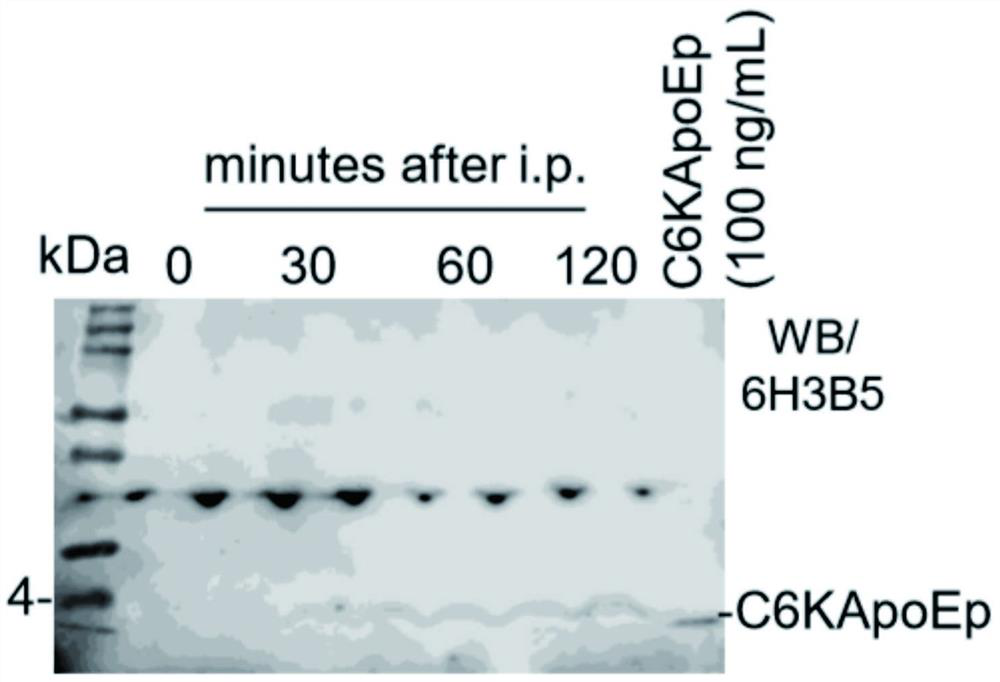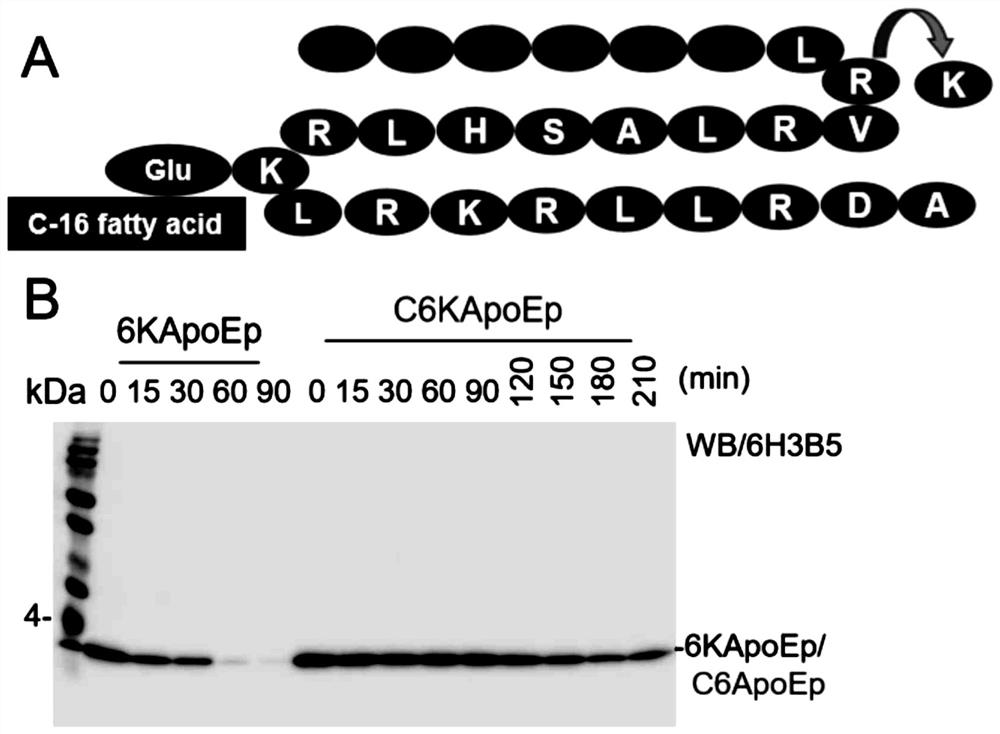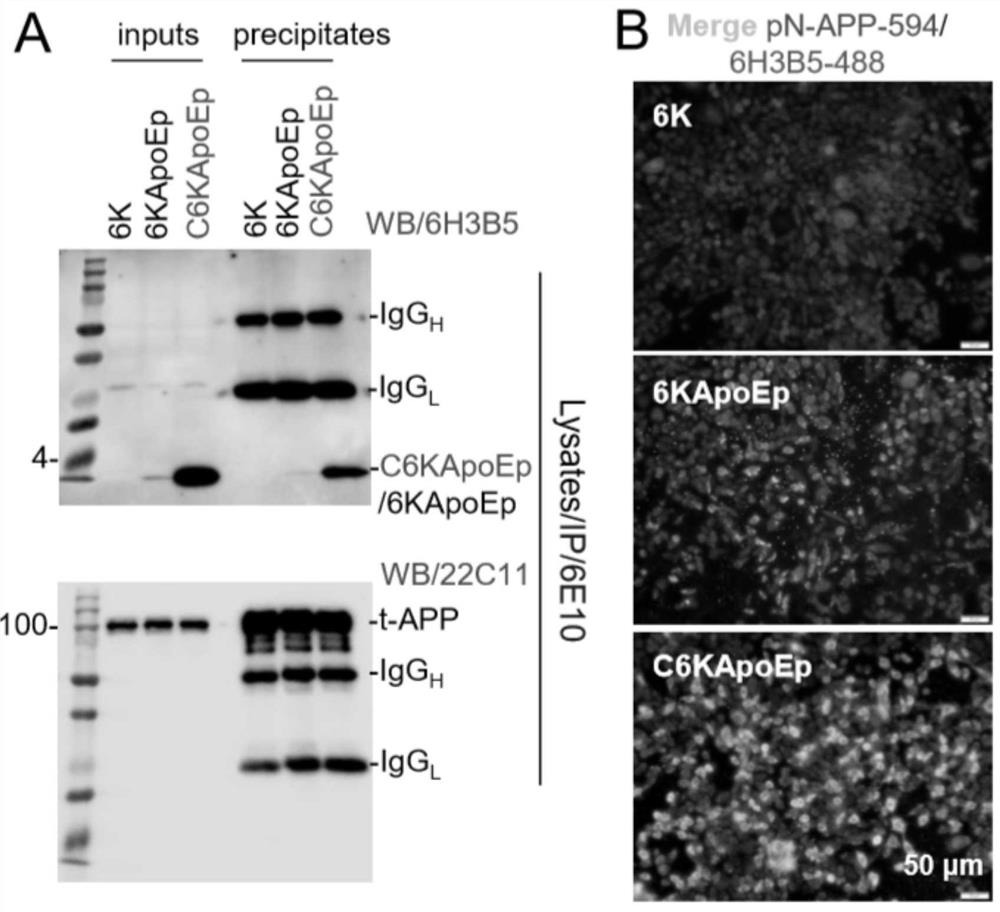Application of ApoE receptor protein oligopeptide blocker in Alzheimer's disease
An Alzheimer's disease, receptor protein technology, applied in the field of synthetic protein peptide drugs, can solve problems such as no effective treatment methods to improve the disease
- Summary
- Abstract
- Description
- Claims
- Application Information
AI Technical Summary
Problems solved by technology
Method used
Image
Examples
Embodiment 1
[0025] Embodiment 1, in conjunction with attached figure 1 The application of the short peptide blocker of a class of ApoE receptor protein in Alzheimer's disease, after peripheral blood administration, C6KApoEp crosses the blood-brain barrier (BBB)
[0026]C-16 fatty acid modified 6KApoEp (C6KApoEp) was administered to male C57BL6 mice at 250 µg / kg i.p. intraperitoneally, and then C6KApoEp in brain homogenate was measured by WB analysis (6H3B5) at 0-120 minutes after treatment, N = 2 mice / time point, WB analysis showed that 30-120 minutes after treatment, a band of about 2-3 kDa appeared in the mouse brain tissue, indicating the presence of short C6KApoEp peptide.
Embodiment 2
[0027] Embodiment 2, in conjunction with attached figure 2 The application of a short peptide blocker of ApoE receptor protein described in Alzheimer's disease, deep modification of 6KApoEp with C-16 fatty acid palmitate can enhance its N-terminal APP antagonism
[0028] In the first step, the modified 6KApoEp is C6KApoEp, MW 3146.22, modifying 6KApoEp by replacing Lys (K) at Arg (R) at position 8, and linking C-16 fatty acid (palmitic acid) with a glutamic acid spacer in the rest Lys residue at position 17 (A), 10 μM 6KApoEp or C6KApoEp was incubated with conditioned medium of CHO cells for 0-210 minutes, and then 6KApoEp and C6KApoEp were analyzed by WB using anti-ApoE LDLR binding domain antibody (6H3B5, B) , compared with 6KApoEp, C6KApoEp shows more stable digestion by endogenous proteases and is very resistant;
[0029] Further, combined with the image 3 , C6ApoEp tightly binds to N-terminal APP. CHO / APPwt cells were treated with 6K, 6KApoEp or C6KApoEp at a concentr...
Embodiment 3
[0033] Embodiment 3, in conjunction with attached Figure 7 For the application of the short peptide blocker of ApoE receptor protein in Alzheimer’s disease, SH-SY5Y cells were treated with 0 (Ctrl), 5 μM and 10 μM C6KApoEp (m6K) or 6K for 1 h, 2 h, After 4 h, 6 h, 8 h, and 24 h, the MTT colorimetric analysis was completed according to the instructions of the MTT test, and the result of the MTT test was shown as the survival rate P > 0.05 relative to the control.
PUM
 Login to View More
Login to View More Abstract
Description
Claims
Application Information
 Login to View More
Login to View More - R&D Engineer
- R&D Manager
- IP Professional
- Industry Leading Data Capabilities
- Powerful AI technology
- Patent DNA Extraction
Browse by: Latest US Patents, China's latest patents, Technical Efficacy Thesaurus, Application Domain, Technology Topic, Popular Technical Reports.
© 2024 PatSnap. All rights reserved.Legal|Privacy policy|Modern Slavery Act Transparency Statement|Sitemap|About US| Contact US: help@patsnap.com










